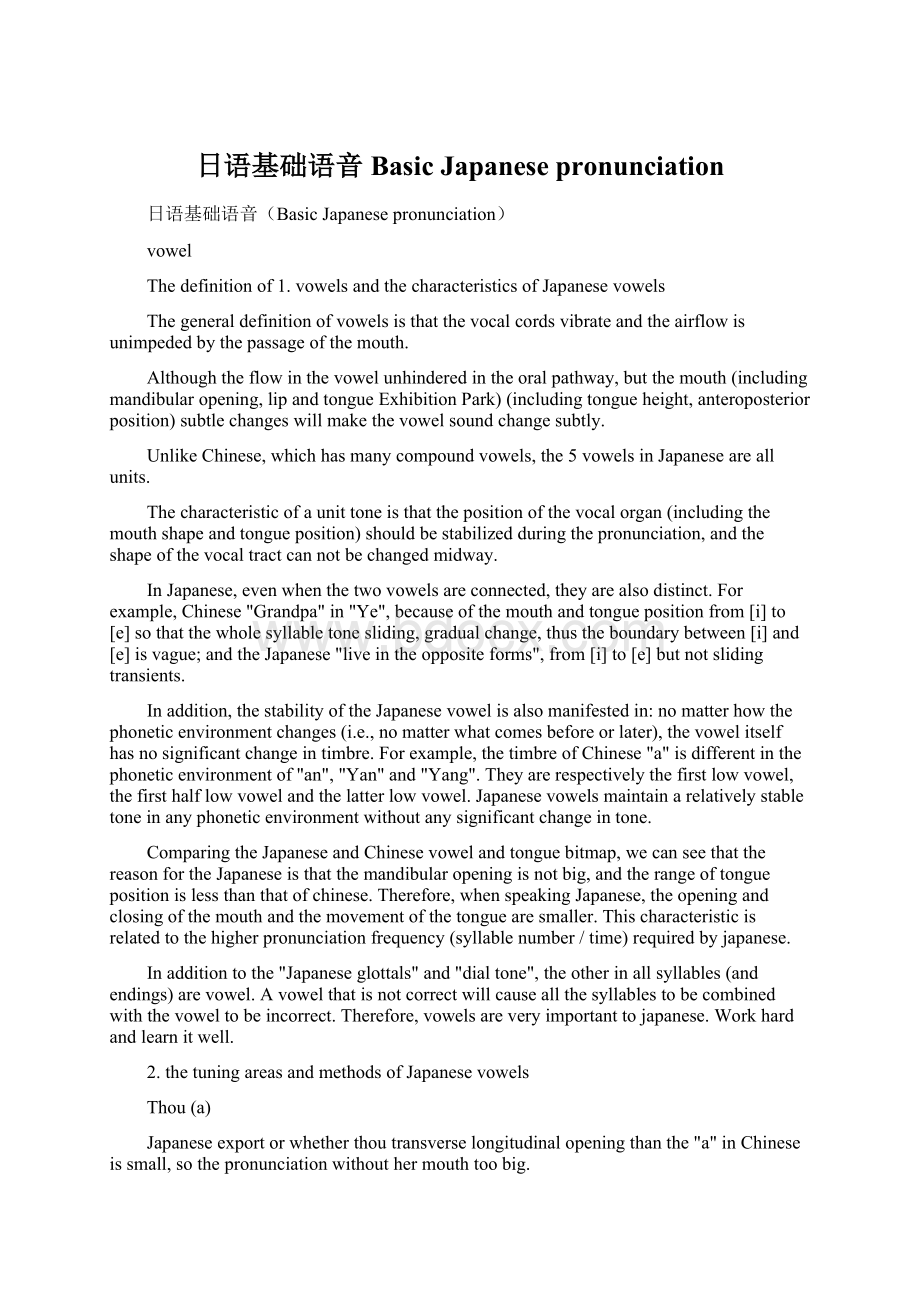日语基础语音Basic Japanese pronunciation.docx
《日语基础语音Basic Japanese pronunciation.docx》由会员分享,可在线阅读,更多相关《日语基础语音Basic Japanese pronunciation.docx(9页珍藏版)》请在冰豆网上搜索。

日语基础语音BasicJapanesepronunciation
日语基础语音(BasicJapanesepronunciation)
vowel
Thedefinitionof1.vowelsandthecharacteristicsofJapanesevowels
Thegeneraldefinitionofvowelsisthatthevocalcordsvibrateandtheairflowisunimpededbythepassageofthemouth.
Althoughtheflowinthevowelunhinderedintheoralpathway,butthemouth(includingmandibularopening,lipandtongueExhibitionPark)(includingtongueheight,anteroposteriorposition)subtlechangeswillmakethevowelsoundchangesubtly.
UnlikeChinese,whichhasmanycompoundvowels,the5vowelsinJapaneseareallunits.
Thecharacteristicofaunittoneisthatthepositionofthevocalorgan(includingthemouthshapeandtongueposition)shouldbestabilizedduringthepronunciation,andtheshapeofthevocaltractcannotbechangedmidway.
InJapanese,evenwhenthetwovowelsareconnected,theyarealsodistinct.Forexample,Chinese"Grandpa"in"Ye",becauseofthemouthandtonguepositionfrom[i]to[e]sothatthewholesyllabletonesliding,gradualchange,thustheboundarybetween[i]and[e]isvague;andtheJapanese"liveintheoppositeforms",from[i]to[e]butnotslidingtransients.
Inaddition,thestabilityoftheJapanesevowelisalsomanifestedin:
nomatterhowthephoneticenvironmentchanges(i.e.,nomatterwhatcomesbeforeorlater),thevowelitselfhasnosignificantchangeintimbre.Forexample,thetimbreofChinese"a"isdifferentinthephoneticenvironmentof"an","Yan"and"Yang".Theyarerespectivelythefirstlowvowel,thefirsthalflowvowelandthelatterlowvowel.Japanesevowelsmaintainarelativelystabletoneinanyphoneticenvironmentwithoutanysignificantchangeintone.
ComparingtheJapaneseandChinesevowelandtonguebitmap,wecanseethatthereasonfortheJapaneseisthatthemandibularopeningisnotbig,andtherangeoftonguepositionislessthanthatofchinese.Therefore,whenspeakingJapanese,theopeningandclosingofthemouthandthemovementofthetonguearesmaller.Thischaracteristicisrelatedtothehigherpronunciationfrequency(syllablenumber/time)requiredbyjapanese.
Inadditiontothe"Japaneseglottals"and"dialtone",theotherinallsyllables(andendings)arevowel.Avowelthatisnotcorrectwillcauseallthesyllablestobecombinedwiththevoweltobeincorrect.Therefore,vowelsareveryimportanttojapanese.Workhardandlearnitwell.
2.thetuningareasandmethodsofJapanesevowels
Thou(a)
Japaneseexportorwhetherthoutransverselongitudinalopeningthanthe"a"inChineseissmall,sothepronunciationwithouthermouthtoobig.
Duetothesmallopeningofthejaw,tongue(thatisformedbetweenthebackofthetongueandpalateupliftofthenarrowestpoint)higherthantheChinese"a"isslightlyhigherandslightlyback,sotheauditoryimpressiononcolorisslightlydarker,asbrightastheChinese"a".ThedegreeofmuscletensioninthelipsandtongueisalsoslightlylowerthanintheChineselanguage.
Pronunciationguidance
Thisismostlikelyarelativelysound,butyourlipsandtonguemusclestorelax,don'tputtoobigmouth.Inlanguagestream,weshouldtryourbesttomaintaintherelativestabilityoftimbre.
Hai(I)
TheverticalopeningofthemouthandmandibleissimilartotheChinese"I",butthetransverseopeningofthemouthissmaller.
ThetonguepositionisslightlylowerthantheChinese"I".Chinesemade"I"becausethetongueishigher,sometimesfeelaslightfrictionbetweenthetongueandpalate.Japaneseliveduetothegapbetweenthetongueandpalateislarge,smoothflow.Ifyoupronouncecorrectly,youshouldnotfeelthefriction.Thisistheouterlipmusclerelaxation.
Pronunciationguidance
Keepyourvocalorgansinanaturalstateofrelaxation.DonotuseasmuchforceastheChineseI.Don'tpullthecornersofyourmouthtobothsides.
Inthespeechstream,afterthelastvowel[a]or[o],theheightofthetonguewillslowdownslightly,isnotasinglesoundwhenthelastsoundsoclear.Thisistheso-called"diphthongization"phenomenon.Butthelastpartinpronunciationconsciousnessstillhasstrongindependence.Itmaintainsaclearboundarybetweenthevowelandthefront.Theglidingprocessfrom[a]to[i]isveryshortandthetoneisalmostinstantaneous.PayattentiontothedistinctionbetweentheChineseVowel"Ai"andthechinese.
U(U)
ComparedwiththeChineseVowel"U"inJapanese,butnotcompletelipflatforward,isa"showvowel".
Thetraditionalvoicetextbooksalwaysemphasizethecharacteristicsoftheunroundeduonotherfactorsdon'tspeakmuch.Butpracticehasprovedthatthemerechangeoflipgardencannotchangethetoneof"U".TheJapanesecompletepronunciation,lipeffectevensmallenoughtobeignored,andthefactorsoutsidethelipismoreimportant.
Fromtheopeningofthemandible,theChinese"U"toopenlarge,openedabout5mmofthedistancebetweentheupperandlowerincisors;Japanesecompletemandibularopeningisminimal,theupperandlowerincisorsoverlapbetweentheupperandlowermolars,thedistanceisverysmall.
TheJapanesecompletetone,thetongueplaysaveryimportantrole.
ComparedwiththeChinese"U",completethelipandtonguemusclesaremorerelaxed.
Pronunciationguidance
Thelipsandtonguemusclesshouldnotbetoohardtokeepthenaturalrelaxationofthevocalorgans.Thereisnoneedtopaytoomuchattentiontolipcircles,aslongastheydonotconsciouslypushtheirlipsforward.Tofocusonthetongue:
recurrentChinese"->u",youcanfeelthemovementofthetongue,tofindthecentreafterabitposition,atthesametimereducethemandibularopeningsothattheupperandlowerincisorsoverlap,basicallycompletethetimbreofthejapanese.
Forms(E)
Lipnaturalexpansion.Thecornersofthemouthareneithertoofarapartnorinward.Thelipofthelongitudinalopeningissmallerthanthou.
Mandibularopeningbetweensweetanddelicious,actuallyalittleclosetotheposition.
Thetongue,withlittledifferencebetweenbeforeandafterthelastformsofdimension(slightlybackalittlebit,andthou)comparedtoalotofdifference(thoutongueverylate).Inhighdimension,locatedclosetothepositionbetweentheformsofliveandlivewiththee.
Fromtonguemuscletension,slightlyhigherthantherearformsofChinese"ie".
Pronunciationguidance
Inthevowelforms,firstidentifythesweettongue,thetonguetokeepthecentralpositionbeforeandafterbasicdoesnotmove,trytodeclineslightlybeforetheheightoftongueandtongue,inplaceyoucangetformsoftone.Keepthefrontheightdowntoomuch.
And(o)
ThisistheonlyroundvowelinJapanese:
whenyoupronounceit,thecornersofyourmouthcontractinwardintoaflatoval.ThelipofthelateralopeningisthesmallestinJapanese,thelongitudinalopeningisslightlylargerthanthelongerthanChinese,but"U"shouldbesmaller.
Althoughthelipofthelongitudinalopeningisnotbig,buttheopeningofthejawisnotsmall:
distancebetweentheupperandlowerincisorsthanChinese"U"isevenlarger,withsimilarforms.
Fromthehighdimensionpointofview,theJapaneseandthetonguealittlehigherthanthou,andChinese"O"isalmostahigh.Butfromtheviewoftheposition,andquitereliable,evenclosetotheJapanesetongueuvula,thebackofavowel.ThetonguepositionofChinese"O"isrelativetothe"a"positioninfrontandbackdimensions.
Fromtonguemuscletension,andslightlyhigherthantheChinese"O".
Pronunciationguidance
Hairandsound,firstidentifytheChineseVowelsinthebackofthetongue"U",andthenputthetonguetodropalittlebelowatthesametime,theopeningofthemandibularagainslightlyopen,andthesoundcanbeobtained.
Halfvowel
Inafricative,theweaker,lessfriction,betweenthevowelandtheconsonant,iscalledthehalfvowel.
TherearetwohalfvowelsinJapanese:
[y]and[w].ComparedwiththesemivowelofChinese,theJapanesehalfvowelisveryclosetovowelbecauseofitsweakfriction.
Insyllables,thelengthoftheJapanesehalfvowelisshort,andthetransitionfromthesemivoweltothevowelisinstantaneous.Thatistosay,inthepronunciationofsemivowelgentlyshortpassing,otherwiseitwillbeperceivedastwosyllables.
Don'troundyourlipswhenyou'remakinga[w].Theactionoftheroundedlipscausesthelipsmusclestobecometense,thusincreasingthearticulationofthevowelsounds,andthisextramovementcanconsumealotoftime.ThisiscontrarytotheJapaneseshortvowelinthesyllable's"shortandlight"characteristics.
InChinese,thelipsemivowel[w]hasa"freevariant"[v],bothofwhichcanbefreelysubstitutedforeachother,buttheJapanese[w]doesnothavethisvariant.
TheconsonantsinEnglishandotherforeignlanguages,[v],areclosetotheconsonant[b]soundsinJapanese,so[v]becomes[b]whenitistranslatedintojapanese.
Longvowel
InJapanese,thelengthofvowelisdistinguishedbymeaning.Suchas:
As(corner)-Dhaka,DoCoMo(card):
(stamp)-cancerwas:
cancerwascomplete(against)
Wait。
Thelengthofalongvowelisapproximatelythesameasthatofthetwo.Thebackofthelongvowel,oritssecondbeat,isgenerallycalledthelongtone".
ForChinesepeople,learningJapanesehastwopointsthatrequirespecialattention:
Oneofthecommonmistakesisthatthelengthofthebeatisnotlongenough.ThisunderminesthesenseofrhythminherentinJapanese,butalsoeasilyleadtomisunderstanding.Thetwocommonmistakesistolovethelongsoundbehindthemoraalsolongsound,suchasthe"completeexamplesexamples"and"Dhaka,no"read"examplescompleteexamplescompletetheform,"and"no".Th